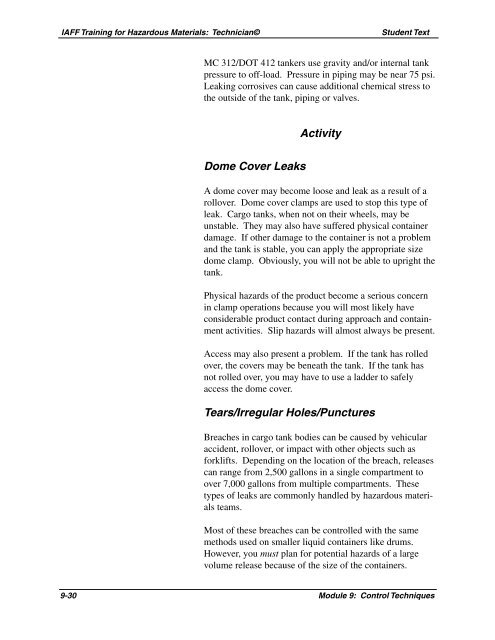Module 9: Control Techniques - International Association of Fire ...
Module 9: Control Techniques - International Association of Fire ...
Module 9: Control Techniques - International Association of Fire ...
Create successful ePaper yourself
Turn your PDF publications into a flip-book with our unique Google optimized e-Paper software.
IAFF Training for Hazardous Materials: Technician©<br />
Student Text<br />
MC 312/DOT 412 tankers use gravity and/or internal tank<br />
pressure to <strong>of</strong>f-load. Pressure in piping may be near 75 psi.<br />
Leaking corrosives can cause additional chemical stress to<br />
the outside <strong>of</strong> the tank, piping or valves.<br />
Activity<br />
Dome Cover Leaks<br />
A dome cover may become loose and leak as a result <strong>of</strong> a<br />
rollover. Dome cover clamps are used to stop this type <strong>of</strong><br />
leak. Cargo tanks, when not on their wheels, may be<br />
unstable. They may also have suffered physical container<br />
damage. If other damage to the container is not a problem<br />
and the tank is stable, you can apply the appropriate size<br />
dome clamp. Obviously, you will not be able to upright the<br />
tank.<br />
Physical hazards <strong>of</strong> the product become a serious concern<br />
in clamp operations because you will most likely have<br />
considerable product contact during approach and containment<br />
activities. Slip hazards will almost always be present.<br />
Access may also present a problem. If the tank has rolled<br />
over, the covers may be beneath the tank. If the tank has<br />
not rolled over, you may have to use a ladder to safely<br />
access the dome cover.<br />
Tears/Irregular Holes/Punctures<br />
Breaches in cargo tank bodies can be caused by vehicular<br />
accident, rollover, or impact with other objects such as<br />
forklifts. Depending on the location <strong>of</strong> the breach, releases<br />
can range from 2,500 gallons in a single compartment to<br />
over 7,000 gallons from multiple compartments. These<br />
types <strong>of</strong> leaks are commonly handled by hazardous materials<br />
teams.<br />
Most <strong>of</strong> these breaches can be controlled with the same<br />
methods used on smaller liquid containers like drums.<br />
However, you must plan for potential hazards <strong>of</strong> a large<br />
volume release because <strong>of</strong> the size <strong>of</strong> the containers.<br />
9-30 <strong>Module</strong> 9: <strong>Control</strong> <strong>Techniques</strong>
















